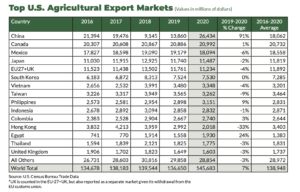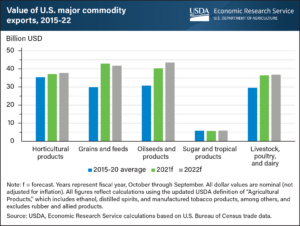Tariffs imposed by the Trump administration collected an estimated $958 million in revenue from selected agricultural inputs from February to October of 2025, according to North Dakota State University's monthly…
Trade Representative Katherine Tai Outlines U.S., China Trade Policy
Wall Street Journal writers Josh Zumbrun, Bob Davis and Lingling Wei reported in Tuesday’s paper that, “The Biden administration began defining its China trade policy Monday, saying it aims to launch new talks with Beijing but will keep existing tariffs in place, while also restoring the ability of U.S. importers to seek exemptions from those levies.
“The new policy, outlined by U.S. Trade Representative Katherine Tai on Monday, largely builds on the China trade policy initiated by former President Donald Trump, who launched the biggest trade war since the 1930s in an attempt to get China to buy more U.S. goods and to stop it from pressuring American companies to hand over their trade secrets.
“Ms. Tai said the U.S. would press China to carry out pledges it made as part of the Phase One accord signed in January 2020—including by maintaining steep tariffs put in place by Mr. Trump on what is currently about half of China’s exports to the U.S. But she said there were no plans to launch an investigation into Chinese trade practices, which had been under discussion within the administration.”
.@AmbassadorTai at CSIS lays out initial steps on how the Biden administration intends to approach its trade relationship with Beijing: “Our objective is not to inflame trade tensions with China.” pic.twitter.com/cyz7OznwGJ
— Jenny Leonard (@jendeben) October 4, 2021
The Journal writers noted that, “A centerpiece of the Phase One deal was Beijing’s promise to boost its purchases of U.S. agriculture and energy products and manufactured goods. The pact called for China to increase purchases of goods and services by an extra $200 billion over the course of 2020 and 2021.
“China missed the goal for goods purchases by nearly 40% in 2020, according to calculations from Chad Bown, a senior fellow at the Peterson Institute for International Economics who has been tracking the effort. As of data for the first 8 months of the year, China is on pace to be 30% short of its goal in 2021.”
Will US farm exports reach the Phase One commitments?
— Chad P. Bown (@ChadBown) October 4, 2021
The answer largely depends on what happens to US soybean exports over the next 4 months.
(Soybeans are HUGE making up nearly 60% of all farm exports covered by the legal agreement. They make or break that sector.)
6/ pic.twitter.com/dbXNThzOA7
DTN Ag Policy Editor Chris Clayton reported on Monday that, “Through July, the U.S. has exported $15.7 billion in agricultural products to China, more than twice the total for the first six months of 2020, according to U.S Census data. The data is skewed, though, because of the impact the COVID-19 pandemic had on overall global trade in the first half of last year. China accelerated imports of agricultural products in the second half of 2020, hitting $26.4 billion for the full calendar year, a record total, but still $10.2 billion below the initial commitment.
“Agricultural exports to China under the phase-one trade agreement were expected to hit $40.4 billion for 2021 and 2022 under the deal.”

And New York Times writers Ana Swanson and Keith Bradsher reported in Tuesday’s paper that, “China denies that it has failed to live up to the trade agreement, contending that the pandemic has created unique circumstances.”
“Ms. Tai said she would begin talking with her Chinese counterparts in the coming days about the country’s failure to live up to its agreements. In a call with reporters Sunday, senior administration officials did not rule out the possibility of imposing further tariffs on China if talks with did not produce the desired results, warning Beijing that they would use all available tools to defend the United States from state-directed industrial policies that harm its workers,” the Times article said.
Meanwhile, Los Angeles Times writer Don Lee reported on Monday that,
Tai did not provide a timetable for when she would start engaging with her counterpart in China, but beyond diplomacy, it wasn’t clear what additional measures the administration can leverage.
Mr. Lee explained that, “China has made good on some pledges related to market access including removing barriers for financial services and some U.S. fruits and meat products.
“The Phase 1 trade agreement includes an enforcement mechanism, but it also has a provision that might allow China to claim that it could not meet its obligations due to the unforeseen circumstances caused by the COVID-19 pandemic.”
The L.A. Times article added that, “The Phase 1 deal was meant as an initial agreement that would lead to talks involving more substantive economic and trade issues, but senior Biden officials said Sunday that they don’t foresee negotiating a Phase 2 deal.”

On Tuesday, Reuters writers David Lawder and Andrea Shalal reported that, “Having waited eight months for U.S. Trade Representative Katherine Tai’s promised ‘top-to-bottom’ policy review of trade with China, some U.S. industries and experts were complaining over the plan’s lack of specifics on negotiations or timing.”





